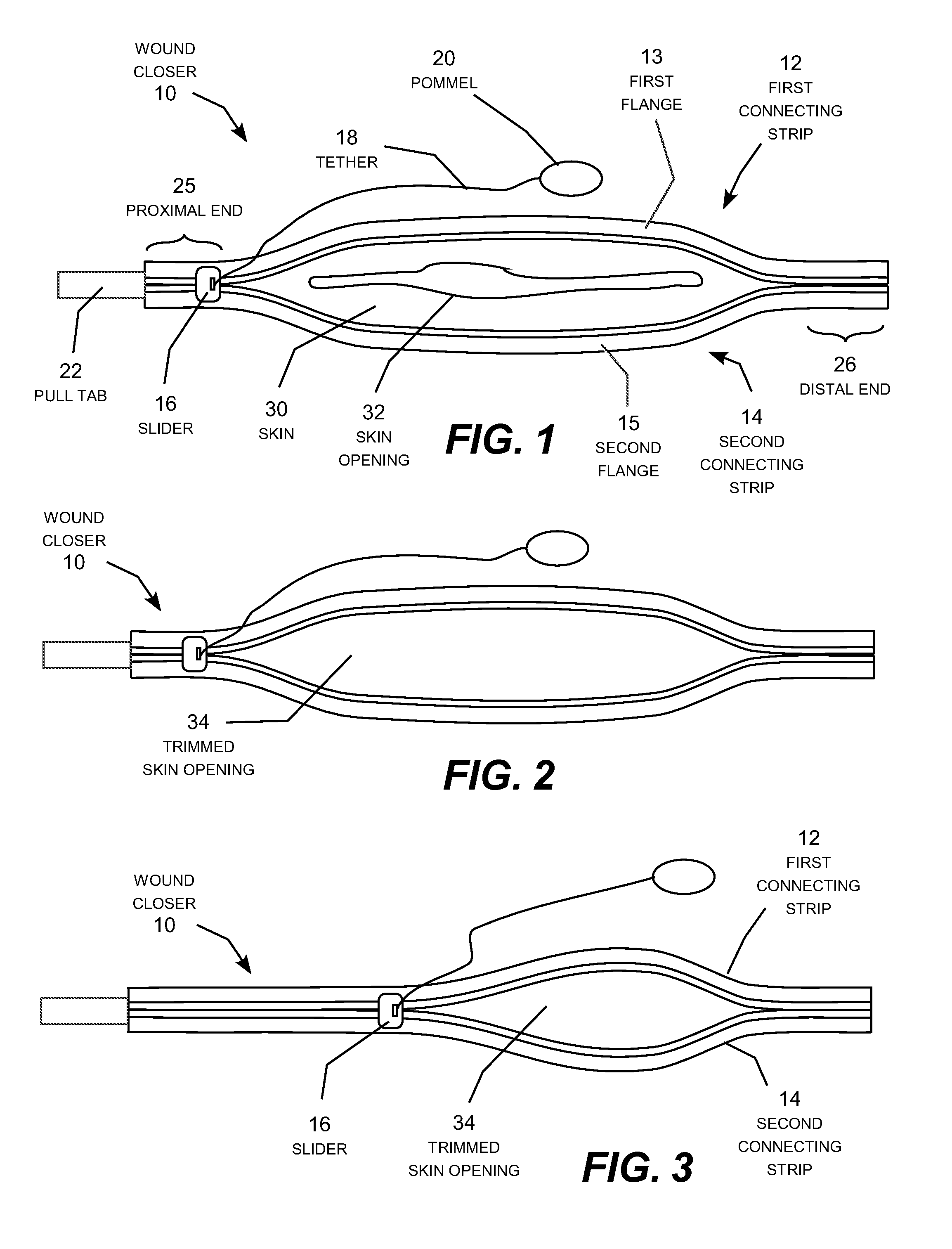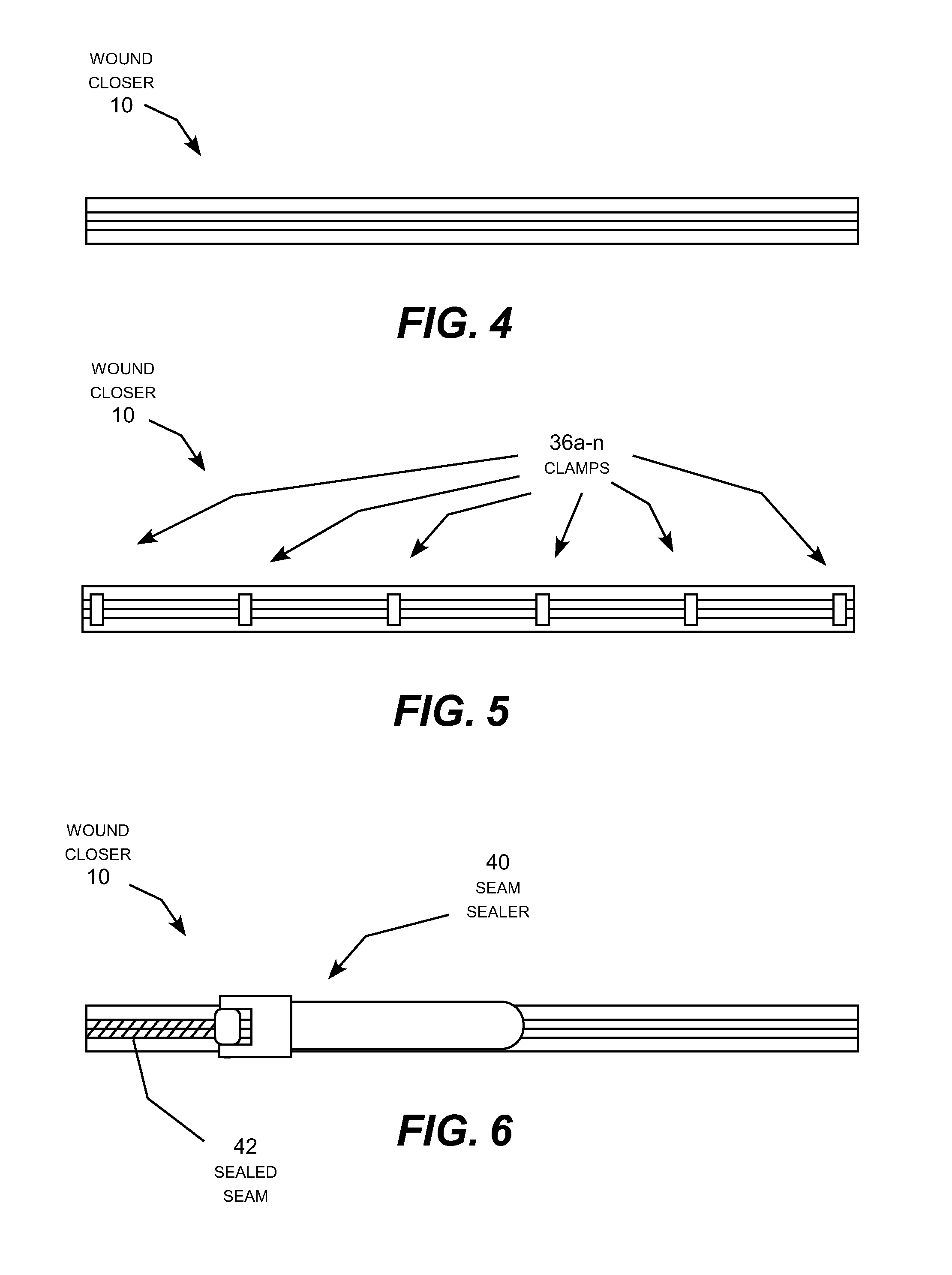[0013]A further
advantage is that a suitably modified wound closer, without trimming the skin, can be used to hold wounds closed in
emergency situations, and help stop bleeding by closing the edges firmly, which can sometimes be difficult to do with
bandage systems. Another
advantage is that the wound closer can be removed by anyone and does not require a second trip to the doctor to “remove the stitches” a procedure that can also be painful. A further
advantage is that stitches that are normally used penetrate the skin sometimes themselves become infected, but since the wound closer does not penetrate the skin this risk is avoided. A further advantage of this invention is that existing scars can be removed by using a big enough wound closer to enclose the skin with the scar in it, then
cutting out the skin containing the scar in the standard manner described above and then closing the wound closer. Another advantage of the method is that it permits wound closers to be manufactured in various shapes to confirm to curvatures of the body such as over an
eyebrow, or curved wounds, such as commonly occurring round a nipple as a result of breast
surgery. Another advantage of the invention is that it permits wound closers to be manufactured in different configurations such as one-piece units pre-joined at the ends complete with zipping device, or as continuous strips on reels that can be
cut to length required, and then separated as required to provide a long enough opening for the wound in question (and then used with a separate closing tool), or as wound zips with narrower or wider feet and hence larger or smaller
adhesive surfaces to suit the anticipated skin stress at the
repair site.
[0014]Generally described, the invention may be practiced as a wound closer that may optionally include an associated knife or knife blade that function together as a method for closing wounds quickly and easily doing so in a fashion to promote scar-free healing of a
skin opening. The wound closer includes a first elongated connecting strip whose foot carries a first
adhesive surface, a second elongated connecting strip whose foot carries a second adhesive surface, and a slider configured to slide along the first and second connecting strips to zip the connecting strips together. The first and second adhesive surfaces are configured to adhere to the skin adjacent to the skin opening and pull the skin opening closed as the slider zips the connecting strips together in a manner similar to that which occurs with zip-lock bags, but in this case as a permanent one-time closure. The connecting strips, when zipped together, preferably form a continuous, toothless water-tight seam to prevent seepage of fluid through the seam. The connecting strips may connected directly to the skin or they may be carried on an
adhesive bandage having a width selected to be suitable for the particular wound to be closed.
[0015]The wound closer may be configured to work with a specially designed knife or knife blade, which is configured to slide along a knife guide disposed along the interior edge of the connecting strip. While trimming may be done with an ordinary scalpel using the foot of the connecting strip as a guide, the optional specially designed knife or knife blade ensures that the skin can be trimmed with the necessary closeness to the inside face of the connecting strip, without at the same time
cutting and damaging the connecting strip itself. More specifically, the knife guide may be configured to receive a guide follower on a knife or knife blade that is specially designed to be used in connection with the knife guide and has the effect of both regulating the depth of the cut, and
cutting the skin flush with the inward-looking face of the connecting strip. For example, the knife guide may be an elongated channel extending along the connecting strip, and the guide follower may be a tab configured to be received within and slide along the channel. In addition, each connecting strip or a
bandage adhered to the connecting strip (or both) may be formed from a microporous substrate configured to allow passage of air and block inward passage of potentially contaminating liquids, and either or both may carry an impregnated antibiotic, anaesthetic or other medically active substances.
[0016]To close and promote scar-free healing of an opening in living
skin tissue, a wound closer is adhered to the skin around the opening. Specifically, the first elongated connecting strip is adhered to the skin adjacent to a first side of the skin opening, and the second elongated connecting strip adhered to the skin adjacent to a second side of the skin opening. A knife is then used to trim the skin along and flush with the inner edges of the first and second connecting strips. Very promptly after trimming, and without first stopping the bleeding that results from trimming, the connecting strips are zipped together by sliding the slider along the connecting strips to fasten the connecting strips to each other and thereby pull the skin opening closed. To further secure the seam formed by the connecting strips, a seam sealer may be used to clamp or set or cure an adhesive in the seam. For example, an adhesive may be deployed in the seam that cures or sets in response to energy applied to the seam, for example by an electrical sealing device that may be slid along the seam or by a device that applies UV or
microwave energy to the seam to cause the adhesive to set. However, any such
energy source used in additional sealing should be so configured so as to avoid delivering damaging energy to the wound itself and causing (for example) undesirable blood coagulation or other wound damage. Additionally, the adhesive or the substance of the wound closer itself, or both may be constructed so as to change the color in response to passage of time (indicating the wound is healed) or to closing the wound closer properly, or to energy applied to the adhesive indicating the adhesive is cured and set, or to any of these, or differently to any selection of these.
[0017]In view of the foregoing, it will be appreciated that the present invention provides a cost effective and rapid wound closing device for closing wounds and promoting scar-free healing of skin openings.
 Login to View More
Login to View More  Login to View More
Login to View More 


